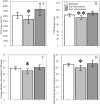POSTURAL STABILITY AND KINETIC CHANGE IN SUBJECTS WITH PATELLOFEMORAL PAIN AFTER A NINE-WEEK HIP AND CORE STRENGTHENING INTERVENTION
- PMID: 28593085
- PMCID: PMC5455181
POSTURAL STABILITY AND KINETIC CHANGE IN SUBJECTS WITH PATELLOFEMORAL PAIN AFTER A NINE-WEEK HIP AND CORE STRENGTHENING INTERVENTION
Abstract
Background: Idiopathic patellofemoral pain (PFP) has been linked to hip weakness and abnormal lower extremity mechanics. The effect of a strengthening intervention on balance has not been well studied among individuals with PFP.
Hypothesis/purpose: The primary aim of this study was to evaluate changes in center of pressure displacement during the single limb squat following a nine-week physical therapy intervention among adolescent females with PFP.
Study design: Interventional and cross-sectional.
Methods: Seven adolescent females with PFP (10 extremities) were included in the study. Center of Pressure (CoP) excursions during a single limb squat task were measured before and after a nine week of physical therapy intervention focused on strengthening of the hip and core. Seven asymptomatic females were matched to the PFP group on the basis of age and activity level, and were tested as a reference group. CoP trajectories were reduced into four variables: mean distance (MDIST), root-mean-square distance (RDIST), range (RANGE), and 95% confidence interval circle area (AREA-CC). Maximum knee flexion angle, peak knee power generation and absorption were also recorded. Linear mixed models were used to test for within and between group differences in CoP metrics.
Results: Pre-intervention, CoP range, knee power absorption and generation were significantly decreased in the PFP group relative to the reference group. Post-intervention, the PFP group reported a significant decrease in symptom severity. There was also a significant (p<0.05) increase in MDIST, RDIST, RANGE, AREA-CC, peak knee flexion angle, peak power absorption and power generation. There was no difference (p>0.05) in knee flexion, knee power or CoP displacement between the two groups after the physical therapy intervention.
Conclusion: Hip and core-strengthening resulted in a significant decrease in symptom severity as well as significant reductions in CoP displacement.
Level of evidence: 3.
Keywords: Balance; hip strength; patellofemoral pain syndrome; postural stability.
Figures



Similar articles
-
Contribution of altered hip, knee and foot kinematics to dynamic postural impairments in females with patellofemoral pain during stair ascent.Knee. 2016 Jun;23(3):376-81. doi: 10.1016/j.knee.2016.01.014. Epub 2016 Feb 10. Knee. 2016. PMID: 26875045
-
Dynamic postural stability and muscle strength in patellofemoral pain: Is there a correlation?Knee. 2016 Aug;23(4):616-21. doi: 10.1016/j.knee.2016.04.013. Epub 2016 May 16. Knee. 2016. PMID: 27198758
-
The influence of hip abductor muscle performance on dynamic postural stability in females with patellofemoral pain.Gait Posture. 2012 Jul;36(3):425-9. doi: 10.1016/j.gaitpost.2012.03.024. Epub 2012 May 16. Gait Posture. 2012. PMID: 22607792
-
Hip and Knee Strengthening Is More Effective Than Knee Strengthening Alone for Reducing Pain and Improving Activity in Individuals With Patellofemoral Pain: A Systematic Review With Meta-analysis.J Orthop Sports Phys Ther. 2018 Jan;48(1):19-31. doi: 10.2519/jospt.2018.7365. Epub 2017 Oct 15. J Orthop Sports Phys Ther. 2018. PMID: 29034800
-
Effects of Hip Abductor Muscles Exercises on Pain and Function in Patients With Patellofemoral Pain: A Systematic Review and Meta-Analysis.J Strength Cond Res. 2019 Nov;33(11):3174-3187. doi: 10.1519/JSC.0000000000002658. J Strength Cond Res. 2019. PMID: 30074970
Cited by
-
Is Postural Control Affected in People with Patellofemoral Pain and Should it be Part of Rehabilitation? A Systematic Review with Meta-analysis.Sports Med Open. 2022 Dec 12;8(1):144. doi: 10.1186/s40798-022-00538-4. Sports Med Open. 2022. PMID: 36504326 Free PMC article.
-
Do Individuals with History of Patellofemoral Pain Walk and Squat Similarly to Healthy Controls? A 3D Kinematic Analysis During Pain Remission Phase.Int J Sports Phys Ther. 2022 Feb 1;17(2):185-192. doi: 10.26603/001c.31044. eCollection 2022. Int J Sports Phys Ther. 2022. PMID: 35136687 Free PMC article.
-
Effects of Patellofemoral Pain Syndrome on Changes in Dynamic Postural Stability during Landing in Adult Women.Appl Bionics Biomech. 2022 May 10;2022:7452229. doi: 10.1155/2022/7452229. eCollection 2022. Appl Bionics Biomech. 2022. PMID: 35592870 Free PMC article.
-
Identifying the Problem Side with Single-Leg Squat and Hamstrings Flexibility for Non-Specific Chronic Low Back Pain.Medicina (Kaunas). 2024 Sep 1;60(9):1428. doi: 10.3390/medicina60091428. Medicina (Kaunas). 2024. PMID: 39336469 Free PMC article.
-
Effects of pain exacerbation on postural control in women with patellofemoral pain during single leg squat: a cross-sectional study.J Orthop Surg Res. 2024 Aug 6;19(1):462. doi: 10.1186/s13018-024-04911-9. J Orthop Surg Res. 2024. PMID: 39107811 Free PMC article.
References
-
- Cichanowski HR Schmitt JS Johnson RJ Niemuth PE. Hip strength in collegiate female athletes with patellofemoral pain. Med Sci Sports Exerc. 2007;39(8):1227-1232. - PubMed
-
- Magalhaes E Fukuda TY Sacramento SN, et al. A comparison of hip strength between sedentary females with and without patellofemoral pain syndrome. J Orthop Sports Phys Ther. 2010;40(10):641-647. - PubMed
-
- Carry PM Kanai S Miller NH Polousky JD. Adolescent patellofemoral pain: a review of evidence for the role of lower extremity biomechanics and core instability. Orthopedics. 2010;33(7):498-507. - PubMed
-
- Powers CM Ward SR Fredericson M, et al. Patellofemoral kinematics during weight-bearing and non-weight-bearing knee extension in persons with lateral subluxation of the patella: a preliminary study. J Orthop Sports Phys Ther. 2003;33(11):677-685. - PubMed
-
- Souza RB Powers CM. Differences in hip kinematics muscle strength, and muscle activation between subjects with and without patellofemoral pain. J Orthop Sports Phys Ther. 2009;39(1):12-19. - PubMed
LinkOut - more resources
Full Text Sources
Research Materials
